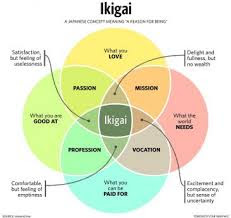These six techniques—Ikigai, Kaizen, Pomodoro, Hara Hachi Bu, Shoshin, and Wabi-Sabi—offer timeless tools to cultivate balance, productivity, and mindfulness in life. By implementing these philosophies, individuals can discover purpose, embrace growth, and lead a fulfilled life.
1. Ikigai Technique: Discovering Your Purpose
Ikigai translates to "reason for being." It focuses on identifying the sweet spot between four aspects: what you love, what you are good at, what the world needs, and what you can be paid for.
How to Apply
- Example: Create a Venn diagram to explore your passion, mission, profession, and vocation.
- Practical Use: A teacher who loves education, is skilled at teaching, meets the community’s need for knowledge, and earns a living finds their Ikigai in their profession.
2. Kaizen Technique: Continuous Improvement
The Kaizen technique emphasizes making small, incremental changes to improve efficiency and success over time. It’s widely used in businesses and personal life.
How to Apply
- Example: Instead of overhauling your entire fitness routine, add a 5-minute walk daily and increase the duration gradually.
- Practical Use: Set weekly goals for work tasks or health habits, and review progress regularly.
3. Pomodoro Technique: Time Management
The Pomodoro Technique is a productivity tool that breaks work into focused intervals (typically 25 minutes), separated by short breaks.
How to Apply
- Example: Use a timer while studying or working—25 minutes of focused effort, followed by a 5-minute break. After four intervals, take a longer 15–30 minute break.
- Practical Use: This method is especially effective for tasks like writing reports, studying, or coding.
4. Hara Hachi Bu Technique: Mindful Eating
This practice, originating from Okinawa, translates to "eat until you are 80% full." It promotes moderation, longevity, and overall health.
How to Apply
- Example: Practice portion control by serving smaller amounts of food and eating slowly to recognize fullness cues.
- Practical Use: Avoid overeating by stopping before feeling completely full, reducing calorie intake without deprivation.
5. Shoshin Technique: Beginner’s Mind
Shoshin refers to maintaining an open, curious, and humble approach to
- Example: A seasoned cook can try approaching a new recipe without assuming prior knowledge, fully immersing in the experience.
- Practical Use: During work meetings, adopt an open mindset to listen actively and consider fresh ideas, even in areas where you have expertise.
6. Wabi-Sabi Technique: Embracing Imperfection
The Wabi-Sabi technique teaches appreciation for imperfection, impermanence, and simplicity, fostering contentment and mindfulness in life.
How to Apply
- Example: Use handmade or slightly flawed items like pottery, appreciating their uniqueness.
- Practical Use: In relationships or self-growth, focus on embracing flaws and celebrating authenticity rather than striving for unrealistic perfection.
These six techniques—Ikigai, Kaizen, Pomodoro, Hara Hachi Bu, Shoshin, and Wabi-Sabi—offer timeless tools to cultivate balance, productivity, and mindfulness in life. By implementing these philosophies, individuals can discover purpose, embrace growth, and lead a fulfilled life.






.png)
Post a Comment